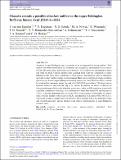Files in this item
Chandra reveals a possible ultrafast outflow in the super-Eddington Be/X-ray binary Swift J0243.6+6124
Item metadata
| dc.contributor.author | van den Eijnden, J. | |
| dc.contributor.author | Degenaar, N. | |
| dc.contributor.author | Schulz, N. S. | |
| dc.contributor.author | Nowak, M. A. | |
| dc.contributor.author | Wijnands, R. | |
| dc.contributor.author | Russell, T. D. | |
| dc.contributor.author | Hernández Santisteban, J. V. | |
| dc.contributor.author | Bahramian, A. | |
| dc.contributor.author | Maccarone, T. J. | |
| dc.contributor.author | Kennea, J. A. | |
| dc.contributor.author | Heinke, C. O. | |
| dc.date.accessioned | 2019-09-11T10:30:03Z | |
| dc.date.available | 2019-09-11T10:30:03Z | |
| dc.date.issued | 2019-08 | |
| dc.identifier | 261032641 | |
| dc.identifier | 96ff89f9-9959-4a66-a5f1-a1cfbe377690 | |
| dc.identifier | 85072276188 | |
| dc.identifier.citation | van den Eijnden , J , Degenaar , N , Schulz , N S , Nowak , M A , Wijnands , R , Russell , T D , Hernández Santisteban , J V , Bahramian , A , Maccarone , T J , Kennea , J A & Heinke , C O 2019 , ' Chandra reveals a possible ultrafast outflow in the super-Eddington Be/X-ray binary Swift J0243.6+6124 ' , Monthly Notices of the Royal Astronomical Society , vol. 487 , no. 3 , pp. 4355-4371 . https://doi.org/10.1093/mnras/stz1548 | en |
| dc.identifier.issn | 0035-8711 | |
| dc.identifier.other | BibCode: 2019MNRAS.487.4355V | |
| dc.identifier.other | ORCID: /0000-0002-6733-5556/work/61370247 | |
| dc.identifier.uri | https://hdl.handle.net/10023/18458 | |
| dc.description.abstract | Accretion at super-Eddington rates is expected to be accompanied by strong outflows. Such outflows are observed in Galactic X-ray binaries and extragalactic ultraluminous X-ray sources (ULXs). However, due to their large source distances, ULX outflows are challenging to detect and study in detail. Galactic neutron stars accreting from a Be-star companion at super-Eddington rates show many similarities to ULX pulsars, and therefore offer an alternative approach to study outflows in this accretion regime. Here, we present Chandra high-resolution spectroscopy of such a super-Eddington accreting neutron star, Swift J0243.6+6124, to search for wind outflow signatures during the peak of its 2017/2018 giant outburst. We detect narrow emission features at rest from Ne, Mg, S, Si, and Fe. In addition, we detect a collection of absorption features which can be identified in two ways: either as all Fe transitions at rest (with a possible contribution from Mg), or a combination of three blue-shifted Ne and Mg lines at ∼0.22c, while the remaining lines are at rest. The second scenario would imply an outflow with a velocity similar to those seen in ULXs, including the ULX pulsar NGC 300 ULX-1. This result would also imply that Swift J0243.6+6124 launches both a jet, detected in radio and reported previously, and an ultrafast wind outflow simultaneously at super-Eddington accretion rates. | |
| dc.format.extent | 1351490 | |
| dc.language.iso | eng | |
| dc.relation.ispartof | Monthly Notices of the Royal Astronomical Society | en |
| dc.subject | Accretion | en |
| dc.subject | Accretion discs | en |
| dc.subject | Stars: neutron | en |
| dc.subject | Pulsars: individual: Swift J0243.6+6124 | en |
| dc.subject | X-rays: binaries | en |
| dc.subject | QB Astronomy | en |
| dc.subject | QC Physics | en |
| dc.subject | DAS | en |
| dc.subject.lcc | QB | en |
| dc.subject.lcc | QC | en |
| dc.title | Chandra reveals a possible ultrafast outflow in the super-Eddington Be/X-ray binary Swift J0243.6+6124 | en |
| dc.type | Journal article | en |
| dc.contributor.institution | University of St Andrews. School of Physics and Astronomy | en |
| dc.identifier.doi | https://doi.org/10.1093/mnras/stz1548 | |
| dc.description.status | Peer reviewed | en |
| dc.identifier.url | https://arxiv.org/abs/1906.01597 | en |
| dc.identifier.url | http://adsabs.harvard.edu/abs/2019MNRAS.487.4355V | en |
This item appears in the following Collection(s)
Items in the St Andrews Research Repository are protected by copyright, with all rights reserved, unless otherwise indicated.

